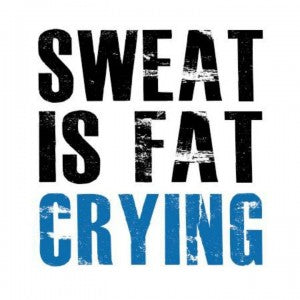The Case for Resting Longer and Lifting Heavier

We love to feel tired in the gym. For many of us, our mission is to not leave the training floor until we feel like our lungs are about to burst and our hearts are on the verge of exploding out of our chests. We crave the burn and chase that pump. It’s not a good workout unless we’re completely drained and depleted, we reason.
Circuit training and bootcamp-style workouts certainly may have their place in an exercise regimen – there’s no denying that. And perhaps logically, it makes a lot of sense; high rep, high intensity, low rest sweat sessions feels like our fat cells are being fried to a crisp. It’s almost as though our bodyfat is literally melting away as we thrust, lunge, and burpee our way to exhaustion.

So, we reason, common sense would dictate that if we want to improve our body composition, circuit training is the way to go.
But sometimes, common sense is wrong.
While men and women are both guilty of opting for bootcamp after bootcamp in hopes of building quality muscle and sizzling away their love handles, I’ve observed that this phenomenon is especially prevalent amongst women. High reps! No rest! Keep your heart rate up the whole workout or else you’re wasting your time! It’s all about the calorie burn! These are just a few statements regurgitated by well-meaning but woefully misinformed health enthusiasts.
Brad Schoenfeld, Ph.D., C.S.C.S., world’s foremost expert on muscle hypertrophy, published a study recently titled, “Longer inter-set rest periods enhance muscle strength and hypertrophy in resistance-trained men,” in the Journal of Strength and Conditioning Research.

In this study, Dr. Schoenfeld and colleagues found that taking 3 minutes of rest vs. 1 minute of rest between working sets of squats and bench press led to greater increases in both muscular strength and hypertrophy. Interestingly, these conclusions don’t exactly mesh with conventional training wisdom that dictates that shorter rest periods are superior for muscle growth (de Salles BF et al., 2009).
Here’s a link to the full paper available on ResearchGate. A Cliffnotes version of the study is below:
- 21 young resistance-trained men performed 3 full body workouts per week, 7 exercises per session, and 8-12 repetitions per set for a total of 8 weeks. One group rested 1 minute between sets (SHORT), while the other rested 3 minutes between sets (LONG).
- Ultrasound imaging was used to measure muscle thickness (MT) of the elbow flexors, triceps brachii, anterior quadriceps, and vastus lateralis. Muscle strength was measured via 1RM testing of the flat bench press and back squat.
- LONG exhibited greater increases in muscle thickness in the anterior thigh with a trend for greater increases in the triceps brachii; increases in vastus lateralus thickness were similar in LONG and SHORT and measured at 11.5% and 10.0% from baseline, respectively.
- LONG exhibited greater increases in muscular strength in both the 1RM squat and 1RM bench press.
Pretty cool, right? But what does this all mean in practical terms? Fortunately, Dr. Schoenfeld was kind enough to jump on a phone call with me earlier this week to answer some questions I had.
Q: Hi Brad, thanks for taking time out of your day to humor me and my probing questions. I understand that there have been studies conducted previously by other researchers comparing different rest periods that didn’t necessarily lead to the same findings as yours. Why did previous research have confounding results?
A: You have to look at who the subjects were (age, level of training experience, etc.) and also the different rest periods compared, plus the methods of measurements. My thinking [based on past research] is that 2 minutes of rest is probably sufficient over something like 1 minute of rest. One study looked at 1 minute vs. 2.5 minutes and found that 2.5 minutes found better results for muscular strength and hypertrophy (Buresh et al., 2009). Another one looked at 1 minute vs. 4 minutes in elderly untrained men and their method of physique assessment was via BodPod (Villanueva et al., 2015), whereas we used direct site-specific measurements (ultrasound to ascertain muscle growth). Based on the literature and looking at where this fits in, 1 minute seems to be insufficient to recuperate strength and ends up compromising volume load. And as we know, volume is important for strength and hypertrophy gains. But for our study, the strength and hypertrophy gains were better in the 3 minute group.
Q: Why was it previously believed that shorter rest periods (30 to 60 seconds between working sets) would be superior for hypertrophy?
A: The proposed mechanism is increased metabolic stress. When you train in the moderate range, you promote a buildup of metabolites (lactic acid, H+, phosphate metabolites, etc.) that accumulate and there is evidence that metabolic stress is a driver of muscle growth (Schoenfeld, 2010). However, we also know that volume is another driver of muscle growth. It would seem that the reduction in volume is not made up for by the heightened metabolic stress. This is the working theory. Metabolic stress also drives acute increases in growth hormones and other systemic factors, but the increases acutely have not been shown to have a substantial effect on hypertrophy.
Q: In other words, total volume load is a greater contributing factor for hypertrophy than metabolic stress?
A: That’s the idea, yes.
Q: But that’s not to say that metabolic stress has no place in a training program, right?
A: Correct. Short interval rest periods are not worthless; we just need to take research into context. It’s not necessarily either-or. For metabolic stress-type work, you could put them towards the end of the workout. This would conceivably increase buffering capacity.
What I generally recommend is to do it more with single-joint exercises. So things like bicep curls, triceps extensions, and glute cable kickbacks would benefit more from the shortened rest. Even the hip thrust would benefit from metabolic stress work. The big compound movements (squat, bench, deadlift) are the ones that you would want to employ longer rest on.
Of course, a lot of this is theoretical. We can only go by the evidence that we have, so when we’re giving advice on this, we have to use some degree of speculation and use the research we have to make our best recommendations. Without evidence to the contrary, these are our suggestions. We can only go by logical reasoning.
Q: Is there a point at which rest periods become too long?
A: The only thing I could think about is that it would be highly inefficient to be in the gym for several hours at a time. If you want to take 10 minutes between sets and that helps you, I don’t think there would be negative effects to that so long as you have the time to spare. I would also imagine it would be important not to let your body temperature drop too much as you’d want to stay warm for your working sets.
Q: I assume we could reasonably apply these practical applications to females as well. Can we apply these findings to different populations?
A: That’s a great question. I can think of no reason why women would respond differently to this. Any researcher could of course say that we did not conduct research on women so we would not be able to speculate. Why would a woman respond differently, though? We would need this study replicated in women to know for sure, but I can’t think of any reason why this would not be the case.
Q: What are your recommendations for trainees then?
A: Based on this study and other previous studies, we probably don’t need to go the full 3 minutes rest in between all working sets. My extrapolation is that 1 minute is too short, but with 2 minutes, you can start to get back enough of your energy capacity. Optimal rest periods will vary depending on the individual, of course, but the suffice to say that in general, longer rest periods will yield better results.

I don’t know about you, but I’m feeling pretty encouraged by this. I can tell you based off of personal experience in addition to working with hundreds of clients (primarily women) that taking more of a breather in between heavy working sets for the main compound movements has helped improve strength, which in turn has led to positive body composition changes. But I’m not the only one who’s made this observation; the top coaches in the strength and conditioning field are in agreement as well.
“Everyone’s worried about burning calories, but they overlook building muscle, strength, and confidence,” reflects Dan Trink, co-owner of Fortitude Strength Club in New York City. “We’ve gotten to the point where, for women in particular, it seems to be all about chasing fatigue. People think that if they get tired, then they’re improving their body composition – but this is not the case.”
Over at 3E Crossfit in Cheshire, Connecticut, owner Ed Williams strives to teach men and women alike about being strong. His clients are prescribed a plethora of deadlifts and other big compound movements. He’s also big on teaching women how to lift heavy weights – creating tension in their bodies and exerting sufficient force to get the bar moving with proper form. “Strength is the foundation of everything that we do,” he says. He reports that his female clients have indeed experienced body composition improvements by training in this matter with longer rest periods, to the tune of 3, 4, and sometimes even 5 minutes of rest between sets.
Ben Bruno, a trainer in Los Angeles who trains a lot of high profile women, uses this same approach for his female clients, and especially pushes heavier weights for hip-dominant movements such as hip thrusts and sled pushes in order to build up the derrière. Here’s a video of one of his clients, Brazilian fashion model Barbara Fialho, performing landmine Romanian deadlifts:
And another of model Kate Upton doing landmine deadlifts with pristine form:
There’s nothing inherently wrong with circuit training per se. But by training exclusively in this manner, individuals may weigh less on the scale while body composition may not improve. As Trink reminds us, getting the “toned” look actually entails having some degree of muscle mass. The idea that lifting heavy weights necessarily makes women bulky is a huge misconception; it’s typically the increased calorie intake and accompanying fat gain that contributes to the “bulky” look, not the muscles themselves. And in order to build muscle mass, we need to be lifting heavier weights. How do we accomplish this feat? By allowing for sufficient rest between working sets.
Understandably, moving away from the “more fatigue is better” mentality is not always an easy endeavor. Many may feel uneasy, as though they’re not doing enough in the gym. What’s the best way, then, to manage this transition?
“Focus on what you can build rather than what you can burn,” Trink advises. And Williams adds, “Find ways to do some of what you want while still doing what you need.” Plug in filler work. For example, in between sets of heavy squats, do face pulls or some mobility drills. This gets you away from sitting anxiously but still has you doing something else that won’t affect your strength.
“Focus on what you can build rather than what you can burn.” – Dan Trink
Here’s an idea of what a sample training day could look like:
A. Back squat 3×3-5 // 3-5 minutes rest between sets
B. Incline bench press 3×5-8 // 3-5 minutes rest between sets
C. Hip thrust 3×8-12 // 2-3 minutes rest between sets
D. Lat pulldown 3×8-12 // 2-3 minutes rest between sets
E. Bodyweight back extension 3×20-30 // 45 seconds rest between sets
F. Seated hip abduction 2×20-30 // 45 seconds rest between sets
It should go without saying that pushing heavy weights and taking longer rest periods in the gym are necessary, though not sufficient, on their own to achieve the physique and performance goals desired. Proper nutrition is arguably more important than training to shed bodyfat, while other factors such as sleep and stress management come into play as well.
The moral of the story? Don’t be afraid to take longer rest between sets, particularly for the big compound movements. Stop chasing fatigue in the gym and strive to build strength and muscle. Employ an appropriate blend of heavier weights with long rest in the beginning of a training session and lighter weights, higher reps with short rest later in the workout for optimal body composition results. Keep the goal the goal.
Thank you, Dr. Schoenfeld, for your ongoing contributions to the field of strength and conditioning.
To end, I shall leave you with clips of women from the #eatliftthrive community lifting heavy weights, taking ample rest between sets, and crushing PRs:
See related:
What Is Progressive Overload?
The Importance of Chasing Strength
Is Spot Reduction Really Possible?
When “Just Lose More Fat” is Not the Answer
Strength Training for Women: 7 Myths
25 Things to Know About Training & Conditioning
25 Things to Know About Fat Loss
References
Buresch, R., Berg, K., & French, J. (2009). The effect of resistive exercise rest interval on hormonal response, strength, and hypertrophy with training. J Strength Cond Res. 23:62-71.
de Salles, B.F., Simao, R., Miranda, F., Novaes, Jda S., Lemos, A, & Willardson, J.M. (2009). Rest interval between sets in strength training. Sports Med. 39(9):765-77.
Schoenfeld, B. (2010). The mechanisms of muscle hypertrophy and their application to resistance training. J Strength Cond Res. 24(10):2857-72.
Schoenfeld, B.J., Pope, Z.K., Benik, F.M., Hester, G.M., Sellers, J., Nooner, J.L,, Schnaiter, J.A., Bond-Williams, K.E., Carter, A.S., Ross, C.L., Just, B.L., Henselmans, M., & Krieger, J.W. (2015). Longer inter-set rest periods enhance muscle strength and hypertrophy in resistance-trained men. J Strength Cond Res. [Epub ahead of print]
Villanueva, M.G., Lane, C.J., & Schroeder, E.T. (2015). Short rest interval lengths between sets optimally enhance body composition and performance with 8 weeks of strength resistance training in older men. Eur J Appl Physiol. 115:295-308.




